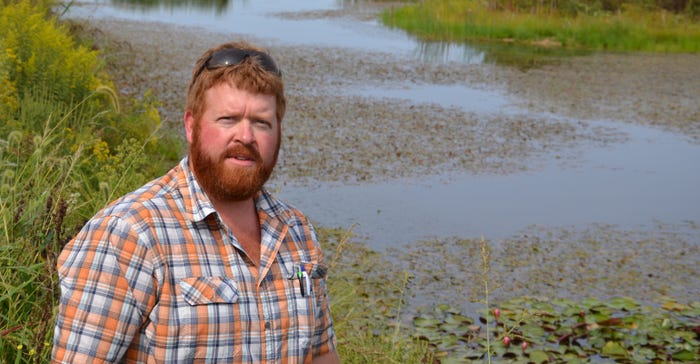
If you think all Conservation Reserve Program land just grows grass and a few legumes, you haven’t visited Nick Holcomb’s place near Westport, Ind. Holcomb’s CRP land, roughly 30 acres, supports a wetland that he installed and specific plants to provide habitat for bees and other pollinators in the area.
Andy Ertel with the Jennings County Soil and Water Conservation District gets excited when he sees what this landowner has accomplished. The Jennings County SWCD promotes pollinator plantings and has helped turn Jennings County into the self-proclaimed pollinator capital of Indiana.
“Nick’s pollinator plantings have been in for several years, and he carries out midcontract management practices,” Ertel says. “These practices help him maintain a good mix of pollinator plants and prevent warm-season grasses from dominating these acres. Coupled with the wetland, it makes a great area for various kinds of wildlife and for pollinators.
“We believe pollinators are important to all types of crop production,” Ertel says. “Our goal is educating people about how important they are, and encouraging people to get involved. If you have land, you can plant pollinator plants and establish habitat which promotes these pollinators. The key is to have a variety of pollinator plants in your mix so that you have plants blooming throughout the growing season, providing a source of pollen for pollinating insects for as long as possible.”
Process begins
Holcomb, who works full time at a local ag retail dealership, started his project in 2011, building his shallow-water wetland. He planted native warm-season grasses and shrubs in 2012. It was a tough year for planting due to the drought. He continued planting in 2013.
Holcomb has the grass and pollinator plantings divided into four plots so he can manage them properly. He is in the midst of the midterm management practices Ertel mentioned.
During this period — usually in years four, five and six of a 10-year contract — one option is prescribed burning. Holcomb has carried out controlled burns on certain plots over the past couple of years. He has the equipment to do it and follows proper procedures to ensure safety. The practice should be discussed with Natural Resources Conservation Service personnel before carrying it out, says Jenny Vogel, a district conservationist with NRCS, based at North Vernon.
“The goal is to burn down vegetation and let the forbs, which are the pollinator starts, have a better chance to compete as everything greens up again in the spring,” Ertel says. “Without some type of midterm contract management, the native grasses can become so heavy that they choke out many of the pollinator plants.”
Holcomb also puts out food plots each year for wildlife. It’s all part of managing the area to protect the environment and promote wildlife and pollinators, he says.
About the Author(s)
You May Also Like




